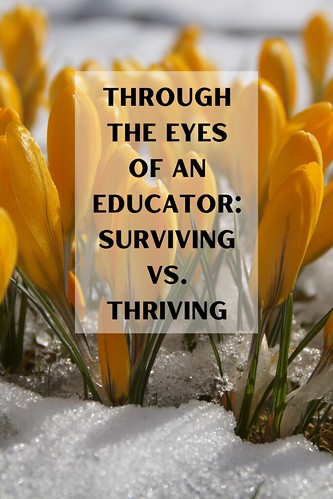Through the Eyes of an Educator: Surviving vs. Thriving
At the turn of a new year, often thoughts turn to dreams, desires—and sometimes even destiny. We rethink, refocus, reset for the next to come. Whether you set intentions, made some of those resolutions, or have given yourself a talking to in order to remain more in the present moment, December turns to January...and then the hard work begins.

As we shift further from those first few weeks, we find ourselves squarely in the midst of that new year. Now what? Do you continue on that intentional path, do you feel your footing wobbling beneath you to stay steady on the path to your dreams, do you flounder from day to day flitting without set goals to keep you on track, or are you managing to make it through each day—and that in itself is a huge win?
Wherever you find yourself within those first few new year weeks, keep in mind our next generation feels it, too. Perhaps they can’t vocalize all the same things, but the newness has worn off and we’re deep into the ‘do the work’ part. How are you feeling?
In positive psychology, thriving and flourishing go hand in hand. According to the father of Positive Psychology, Dr. Martin Seligman, flourishing is “to find fulfillment in our lives, accomplishing meaningful and worthwhile tasks, and connecting with others at a deeper level – in essence, living the ‘good life.’” (Seligman, 2011) In essence, it’s the thriving aspect of life versus the surviving aspect. Psychology Today tells us, “surviving is a grim struggle—you’re white-knuckling life, just barely getting by. Thriving is living and thinking abundantly. Surviving is a drag, a daily slog to stay alive. Thriving is joyful and infectious.” In this sense, being infectious is a good thing.
Amidst the ebbs and flows of the past few years, many of us have been in a constant state of surviving. The epic pathogen that forced living in the pandemic has set a course of a giant shift in what we used to do and what we do now. Much of the last many months have been met with revving up our resilience, managing our moves, assessing endless risk factors on top of the usual look both ways before you cross the street, and quite literally trying to make it through the day. We’ve had pockets and peaks of thriving along with the drudgery of surviving, but it is surely possible that the last 24 months have shown us more of that surviving thought process, rather than the joys of thriving.
How do we shift the focus?

Most significantly, noticing at what place we’re in matters. Then, having and being able to access the tools to change that focus from surviving to thriving comes next. And, as with every habit, resolution, life-change, and goal, the road forward is paved with sweat equity and hard work. The good thing about that hard work is that any little bit is progress.
Consider a messy room, perhaps one occupied by one of those learning and growing students in your home. Perhaps it’s taken years for that occupant to notice it’s messy. Then, there’s potentially the overwhelm of the process and the unknown of how to move from mess to non-mess, along with the possibility of the discomfort in the clean, decluttered openness. Once the awareness is there and the desire to move is present, the work begins. Perhaps to tackle the entire setting is too much, but each small act matters, each is important to the process. Some days we take on more and then some days a new pile arises. That’s okay.
Each step rewires the brain. Each step moves us closer to the place we wish to be. Each step makes a change, one that can be seen, felt, and acted upon again. Soon, the room will look completely different...and the item most changed will be its occupant.
Transitioning from surviving to thriving is a challenge. Potentially, that survival mode we’ve lived in so long feels comfortable (i.e., the teen’s messy room). The familiar mess is comforting; acting on changing it to the unknown is uncomfortable and tests our resolve. Once that choice to shift from one to the next is activated, the rewiring process begins. We remodel the look on the outside while we do that tough inner work to change our mindset and outlook. Like building up our biceps, training for a marathon, working towards that black belt, or learning a new language, it’s the deliberate daily actions that make the difference.
Like the cha-cha, it may be a few steps forward and a few backwards. However, the consistent direction will remain forward-seeking. Each action moves you forward. Each step reminds those thriving, joy-seeking muscles that we want them there, we’re willing to do the work to build them up, and we know that no matter how much we feel like we might be where we started, our awareness has been activated, focus fostered, and mantras manifested so we know that we’re already far further along the path than we realize.
We can get there, I’m sure. We can gather our strength, weather the emotions, curate our community, and access that abundance. Dr. Seuss’s Oh The Places You’ll Go told us that “we’ll move mountains.”
Here’s to a year of mountain moving...a year filled with abundance, joy, and more thriving mindsets for us all.

4 Steps to Help Shift from Surviving to Thriving

Take a step, step again
Disney’s Frozen 2 quite literally shows us of those often dark moments that can affect us all. Big life changes can break our heart in two, and have the potential to place our minds in full-fledged survival mode. “Take the step, step again,” it moves us in more than that physical space. Tugging at our mental gymnastics and forcing our emotional muscles to move from one stage to the next sets a stage for a magnificent shift.
Sometimes the entire room is too much to tackle, but a small corner or shelf? Doable. Each mindset shift towards abundance and joy repositions us from surviving to striving to thriving. Take the step...you have an army of supporters walking beside you.

Employ all the tools
Years ago, it felt taboo to stand in the self-help section of the local bookstore seeking tools for personal growth and development. Today, thankfully, we’ve moved towards a more open conversation about mental and emotional health, the importance of working to being our best selves, and realizing that we must use our voice to speak up for ourselves. Whether you’re a fan of books, podcasts, mindfulness, movement, docu-series, apps, or one of a million other methods, today, tools we can utilize to empower ourselves to thrive are more accessible than ever before. And, as always, you are the most important tool there is. Surviving is hard. It’s a struggle, it’s tough on the entire demeanor and sense of self, and can lead to burnout, depression, and strife.
Sometimes the tool is to remember what brought you joy as a child and do more of that. Sometimes the tool is to journal where you are and where you want to be. Sometimes the tool is a moving meditation or mindful moment, and sometimes the necessary tool is to talk to a professional. Employ all the tools—use them well.

Exercise an abundance mindset
In a perfect world, all kids would be healthy, safe, and loved; the only thing they’d ever have to consider is being a child and living their best life. Picture what that would look like for you. Verbs like play, jump, run, sing, dance, skip, paint, laugh, snuggle, giggle, love, read, write, create, build, hug, help, wiggle, bake, and more fling to the front of the mind. Each conjures a colorful, brilliant story that exudes endless happiness and fun and invites others to join in the merriment.
The abundance mindset is similar; it “refers to the paradigm that there is plenty out there for everybody.” It’s the glass half full motto, the feeling of the people who feel like sunshine, and the “nothing is impossible” Walt Disney attitude. Gratitude reminds you that what you have is enough and helps the abundance mindset send you on a course of believing in those endless possibilities.
Those mindsets are ours to access if only we’re willing to give it a try.

Build your joy-seeking muscles
Survival feels sluggish, joy feels freeing. Surviving feels like work, thriving feels like play. While we’ll all have moments in both, if we give ourselves that call to action to move from surviving to thriving, we can’t lose. Consider the early mornings that are tough to move yourself from bed to yoga mat. The familiarity of the bed is comforting, and while rest is a vital part of the process, if we remain in that bed and never force ourselves to move, how will we build those muscles?
Choosing joy is the same.
Sometimes it’s easier to remain where we are, and sometimes we need help to learn how to move to that next phase. Each time we seek joy, choose happy, and elevate our endorphins, we activate those happiness chemicals, and strengthen those muscles. Like building our physical muscles, it takes real work, actual effort, and often isn’t noticeable in the beginning...yet every action moves you closer to better health.

End Note:
Seligman, M.E.P. (2011). Flourish: A Visionary New Understanding of Happiness and Well-being. Simon & Schuster: Free Press.
Please click the photo below for a collection of my Through the Eyes of an Educator columns:
Stacey Ebert, our Educational Travels Editor, is a traveler at heart who met her Australian-born husband while on a trip in New Zealand. Stacey was an extracurricular advisor and taught history in a Long Island public high school for over fifteen years, enjoying both the formal and informal educational practices. After a one year 'round the world honeymoon, travel and its many gifts changed her perspective. She has since left the educational world to focus on writing and travel. She is energetic and enthusiastic about long term travel, finding what makes you happy and making the leap. In her spare time she is an event planner, yogi, dark chocolate lover, and spends as much time as possible with her toes in the sand.
Check out her website at thegiftoftravel.wordpress.com for more of her travel musings.



















